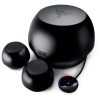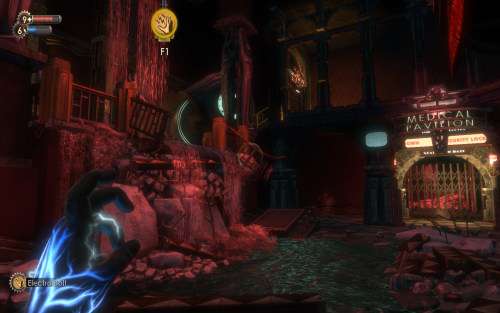- Qualcomm Launches Snapdragon 4 Gen 2 Mobile Platform
- AMD Launches Ryzen PRO 7000 Series Mobile & Desktop Platform
- Intel Launches Sleek Single-Slot Arc Pro A60 Workstation Graphics Card
- NVIDIA Announces Latest Ada Lovelace Additions: GeForce RTX 4060 Ti & RTX 4060
- Maxon Redshift With AMD Radeon GPU Rendering Support Now Available
Razer/THX Mako 2.1-Channel Speaker System

Razer is well-known for producing high-quality peripherals, but audio can be an entirely different bag. Our concerns over their new found venture can be set aside though, as the tag team effort between them and THX helped build an amazing 2.1 system that’s actually worth its $400 price tag.
Page 4 – Listening Tests
Razer’s Mako 2.1-channel speaker system promises to redefine the state of the art in PC sound reproduction – a lofty claim indeed. To accomplish this, Razer enlisted the help of THX Ltd. to elevate the acoustic design of the system with a pair of advanced technologies intended to solve specific problems associated with high-fidelity reproduction on the desktop. However, all the ‘advanced technology’ in the world is little more than a marketing gimmick if it doesn’t produce noticeable improvements in the listening experience.
Methodology and Equipment
To test the Razer Mako speakers, I used all the included cables, and hooked the system up to my ‘Reference’ PC, which represents a modest mid-range machine in terms of computation and graphics performance, but is specially outfitted to be a faultless audio source. Its ASUS Xonar D2 sound card is the cleanest and clearest we’ve ever heard, with plenty of dynamic range, and the highest-quality Burr-Brown DACs and op-amps, placing it in the realm of high-end audio componentry in terms of component quality. Material was available in WMA, FLAC, and CD format, and I listened to a broad variety of program sources while testing the Mako system, though for critical listening, I restricted myself to specific material that I felt would be the best challenge for the Mako system’s capabilities.
The “Ground Plane” speaker design requires that the satellite speakers be placed on a flat surface, so I used a fairly solid desk with a heavy 3/4″ particle-board surface finished in smooth woodgrain vinyl laminate. That’s right – even the surface characteristics come into play with these speakers. Setting them on carpet for some preliminary testing, I noticed that the highs sounded rather muted, so you definitely need a hard, smooth surface to set the satellite speakers on. Placing the subwoofer on carpet, however, produced no ill effects, so you’re good there.
- The Testing Rig
- CPU: AMD Athlon 64 X2 5200+ 2.6GHz
- Motherboard: ABIT KN9 Ultra (NForce 570; MCP-55)
- Memory: 2 GB OCZ Gold DDR2-1100 @ DDR-800
- GPU: ATI Radeon HD 3870, 512MB
- Sound Cards: ASUS Xonar D2, Creative Sound Blaster X-Fi XtremeGamer Fatal1ty Professional
- PSU: Antec NeoHE 500W
- Silent microprocessor-controlled cooling system
- Reference Headphones: Beyerdynamic DT 770, “2005” Edition (250 Ohm)
Music Testing
I remember the alternative group EVE 6 well; their runaway hit song “Here’s To The Night” had to have been the official ‘class song’ of every high school graduating class the year it came out. Their music came to my attention again when the recently-reformed group came to play at Purdue University earlier this year. A friend and I picked up tickets and went, and I acquired a newfound respect for the group’s music and attitude, so it’s no surprise that their energetic Horrorscope found its way to the top of my “CDs To Buy” list on short order. It easily found its way into my CD tray for the Mako system testing as well, thanks to its driving bass lines, meaty guitar, emphatic kick drum line, and awesome vocal harmonies.

The first thing I noticed about these speakers was their very lively, spacious midrange. Below a certain frequency, these speakers function as true hemispherical radiators, but even in the upper midrange, the satellite speakers have a toroidal radiation pattern created by the annular “Ground Plane” opening at the base of the satellites. Vocals filled my room, seeming to create a cascading waterfall of sound behind, beside, and even above me.
The midrange isn’t the most liquid that I’ve ever experienced, but it’s far and away the smoothest and richest I’ve heard from a PC speaker. The highs from the “Slot Speaker” aperture seemed to contain a bit of top-end hash that I didn’t hear on my main system’s front-radiating speakers, though both possess metal-dome tweeters. It’s possible that the Slot Speaker aperture is to blame here – whenever a designer chooses to constrain high frequencies to a waveguide, the internal structure must be very carefully optimized to prevent internal reflections. The Mako satellites’ clarity wasn’t necessarily impaired by this – but their treble did seem a bit ‘veiled’, not really ‘real’. To be perfectly honest, I heard smoother, more natural treble from the old Klipsch ProMedia speaker systems, but only by a little. Most listeners aren’t likely to notice this.
That’s the bad news, if you’d even call it that… but there’s still quite a bit of good news when you take a peek under the table at the Mako system’s beefy subwoofer. The sealed, electronically-assisted design produced tight, muscular low end that went every bit as deep as the Logitech Z Cinema’s subwoofer, and deeper still. It held its composure even at uncomfortable listening levels, as waves of bass waffled the legs of my pants with the kick drum hits. On “Here’s To The Night”, the thunderous low end stayed clean, even at higher volumes. The Mako’s bass can be subtle when it needs to be, yet surprise you with its power when you decide to crank things.

To see exactly what the Mako’s subwoofer was capable of, I cued up my quintessential bass test track, Three Six Mafia’s “Late Nite Tip.” This track has plenty of sustained, deep bass tones that make ordinary woofers cry ‘uncle’, so it’s a popular test track among the car audio crowd as well. To put it simply, I was astounded – the bass from this subwoofer really must be heard to be believed. “Late Nite Tip” unleashed a torrent of pant-leg-waffling bass that hung with the track, even down to the lowest notes, and with authority. As I increased the volume, the low end never began to sound strained, though I did notice that it gradually began to duck out of the way.
So the Mako’s sub still has some limit to its performance, but unless you’re a hip-hop bass freak, you’re unlikely to ever find it. To determine just how deep the Mako’s subwoofer could reach, I popped in my Bassmekanik Faster, Harder, Louder bass test CD, and began stepping through the sine wave tracks at the end of the disc. I found that I didn’t begin hearing meaningful in-room output until 35 Hz, so the 25 Hz specification for this sub seems a bit optimistic.

To try the Mako speakers with an entirely different kind of music, with more acoustic instrumentation, I put in a CD I hadn’t listened to in quite some time, Steven Curtis Chapman’s All About Love. The Mako speakers remained incredibly clean and composed even through complex passages, and I was once again captivated by their smooth midrange and expansive soundstage. These speakers don’t produce a stereo ‘image’ that’s particularly precise, but instead produce sound that engages the room, and creates a sense that you’re in the middle of a sonic environment. The bass could lose impact and ‘slam’ at extremely high volumes, as the limiters began to kick in, but this was already at extremely loud levels that I’d never subject myself to for more than a few minutes at a time.
Gaming
Razer targets their high-end input devices chiefly toward gamers, so I pulled up BioShock to give the Mako speakers a gaming workout, to see if their Razer pedigree would show up in a gaming situation.

In testing the Mako speakers, I played through the “Medical Center” level of BioShock, and loved the way that the broad omnidirectional dispersion of the Mako speakers complemented the cavernous, echo-filled virtual spaces of the game itself – yet the apparent sense of spaciousness seemed to naturally collapse down as I entered smaller, less-reverberant rooms. I still had the ASUS Xonar D2 sound card’s DS3D GX 2.0 extensions enabled (from my earlier article comparing DS3D GX 2.0 to Creative’s EAX 5.0), so the more realistic reverberant effects contributed by the DSP extensions were clearly audible through the Mako speakers in all their fullness. Explosions were delivered powerfully and impactfully by the subwoofer, and the general sense of ambiance contributed by the subwoofer’s deep-bass output heightened the experience.
Movies
I’d recently picked up Tears of the Sun starring Bruce Willis, so I popped the DVD in to see how the Mako speakers would handle this DVD’s rich soundscape. I found that the Mako speakers were adept at calling out details like the rustle of leaves and the crunch of vegetation and gravel underfoot, as well as delivering the “thump, thump, thump” of helicopter blades whirling through the air. Voices, of course, were delivered naturally and richly, and the few large explosions in the film were also delivered with steel-fisted authority, and without any audible complaint.

When it comes to impactful, high-energy movie playback, the Mako speakers certainly have what it takes, and Tears Of The Sun provided enough sonic challenges to effectively showcase the realism with which the Makos were able to paint the sonic landscapes of the African jungle. While the Mako speakers don’t deliver true surround sound, their omnidirectional dispersion allows them to cast a diffuse sound field, heightening the sense of spaciousness with movie sound effects.
Controls
The fingertip controls are slick as snot – though I found them a little reluctant to respond to true fingertip control at first. Using the entire pad of my finger elicited better response from the touch controls. Also, the sensitive part of the touch control pad isn’t directly on top of the illuminated volume bars, but just inside it. So if you’re wondering why the volume control doesn’t seem to be responding when you drag your finger along its path, that’s why. A small tag will be included with the retail product to inform users of this minor detail.
In my critical listening and usage testing of the Razer Mako 2.1 system, I discovered that there’s plenty for audiophiles of all stripes to get excited about, whether your thing is music, gaming, or desktop theater. Next, we’ll wrap things up with my final thoughts.
|
|
Support our efforts! With ad revenue at an all-time low for written websites, we're relying more than ever on reader support to help us continue putting so much effort into this type of content. You can support us by becoming a Patron, or by using our Amazon shopping affiliate links listed through our articles. Thanks for your support!




